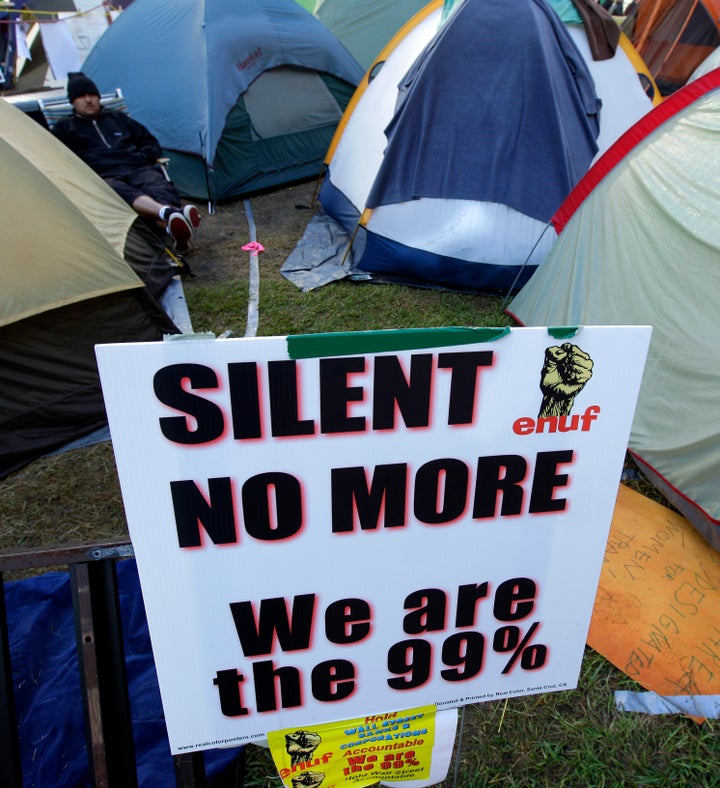
The Occupy Wall Street movement is a helpful reminder that banks were bailed out by taxpayers while households received no significant government help in avoiding foreclosure, lessening debt burdens, or finding work through a serious economic stimulus. But, we might wonder, why is this anger flaring up now, when economists declare that the Great Recession is over? The answer is the economic condition of millions of individuals is either worse or no better than it was at the depth of decline in 2009. It was recently reported that median household income, adjusted for inflation, has fallen 6.7 percent since the official end of the recession. That verified what millions know to be true -- that inequality has gotten out of hand and no abatement is in sight.
The decline of median income does not represent the reversal of a previously upward trend. To the contrary, the standard of living for most Americans has been in a downward trend for a decade. On the eve of the Great Recession, in 2007, median income was lower than it had been in 2000, the eve of the prior recession. Now it has dropped more. In the three decades prior to 2000, household income for 95 percent of Americans was basically stagnant while the top 5 percent of households captured most of the growth of income. In other words, income inequality marched ever upward, approaching its former zenith of the roaring 1920s.
The long-term rise of income inequality was a major cause of the unprecedented and unsustainable increase of household debt that brought on the financial crisis and Great Recession. That overhang of debt is hindering our recovery from the Great Recession. Beginning in the late 1970s households attempted to offset their mostly stagnant incomes with three strategies: greater labor force participation by women, working longer hours and/or more than one job, and borrowing and reducing saving to maintain their consumption. The resort to borrowing at an unusually high rate began in 1995. The period from 1995 to 2007, especially post-2000, can be characterized as a perfect firestorm of household indebtedness, fueled by four factors: 1) stagnant or declining real incomes for most households because of the long-term rise in income inequality; 2) unusually low interest rates after 2000; 3) legal and institutional changes that relaxed borrowing standards of lenders, raised the availability of credit, and made housing a more liquid asset; and 4) the housing price bubble. The end came in 2006-2008 with the bursting of the housing price bubble, rising interest rates, the financial crisis, and the Great Recession. It is widely agreed that the enormous run-up of household debt triggered the financial crisis of 2007 and the Great Recession.
In all that has been written about the financial crisis and the Great Recession, the usual suspects fingered are low interest rates, shockingly easy credit, the housing price bubble, and reckless leveraging by banks. No noted economists have placed income inequality in the lineup of villains. Long ago, Keynes argued that a more equal distribution of income promoted the strong consumption spending required for full employment. Contrary to Keynes, Milton Friedman claimed that income distribution was not relevant for the theory of consumption. Friedman won that argument, so his theory of consumption, which posits no role for the distribution of income, has become the mainstream theory.
One pillar of Friedman's theory is that the rate of saving would be stable in the long run. That assumption, although correct for long periods in the past, was not true for the long period prior to the Great Recession, from 1984 to 2007, when it fell from 10 percent to a low of 2 percent of disposable income. What were consumers doing with all that money they chose not to save and that they borrowed with second mortgages and house refinancing? Federal Reserve data show that they were not purchasing financial assets or paying off other debts. They were spending it. One would think that the drumbeats of a declining saving rate and rising debt leading up to the Great Recession might make mainstream economists question the theory, but that has not happened. Their theory blinded them to the facts.
To develop a strong economic recovery and avoid another decade of stagnant income, we need a more equal distribution of income that would promote the strong consumption spending required for full employment. This means enacting a serious stimulus package, protecting collective bargaining rights, and instituting help for homeowners and the long-term unemployed -- tall orders indeed with the Senate Republicans determined and able to block any such efforts. Occupy Wall Street may lack an agenda, but their actions and our grim situation should move Obama to take bold steps. This agenda would anger the banks and Congress, but Obama would be doing the right thing. And given the current unpopularity of the banks, Obama needs them as enemies going into this election.